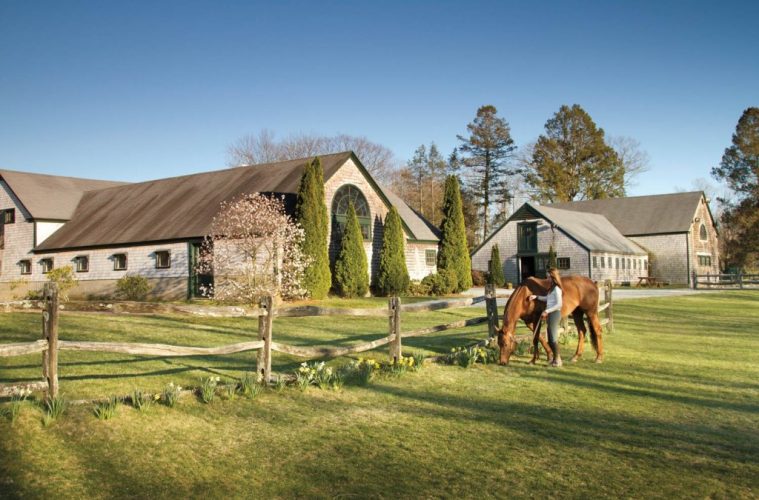A look back in time at the history of Myopia Polo and why it still matters today. By Alexandra Pecci
When 17-year-old Crocker Snow, Jr. rolled up to an Air Force base in Tucson, Arizona, to visit his half-brother, the late Don Little, he likely never imagined that Little’s invitation to “bang around” with a polo mallet would help lead to the rebirth of Myopia Polo Club. “One thing led to another,” Snow says. “It wasn’t any great master plan. It was more spontaneous combustion.”
Whether the revival was planned or not doesn’t matter; what did matter was that Myopia Polo was in dire need of a renaissance. Many of the area’s polo families had been splintered by war as their sons left to enlist before and during WWII, and by the mid 1950s, the historic Gibney Field had nearly turned into a hayfield, thanks to 20 years of neglect during the war and post-war years. That overgrown field was a far cry from Myopia’s early days in the 1880s, when the matches were heralded by brass bands and chronicled in newspaper reports, and where hundreds of spectators from across the North Shore would roll up in their carriages to watch.
The year 1887 saw the first polo match played at Gibney Field, making Myopia Polo Club the oldest active polo club in America. It was also one of the charter members of the United States Polo Association, and according to Snow, is the only one of the original five members that is still in existence.
During the decades that followed, polo’s popularity grew, and in 1907, Gibney Field hosted one of the first formal intercollegiate games between Harvard and Yale. Fathers and sons played side-by-side, and by the 1920s, Myopia Polo Club was hosting an annual invitational tournament, with as many as eight visiting teams coming to Hamilton.
Although the post-WWII era was tough on the club, the love of polo on the North Shore was simply lying dormant, waiting to be revitalized. Snow says Little pushed him to once again encourage polo back home in Hamilton, especially among those who were involved with Myopia before the war.
“There were a lot of people who had played, and they were just waiting for some young blood to come along,” Snow remembers. He was one of the ones who were involved with first cutting away the field’s overgrowth, helping to revive the momentum and player interest, and gradually getting Gibney Field back in shape for polo.
The duo’s efforts paid off. By the late 1960s and early ’70s, Myopia was once again a polo powerhouse in Massachusetts, with bigger crowds, more tournament participation, and more sponsorships than ever. It was even featured in the Steve McQueen film The Thomas Crown Affair. Don Little was captain of polo at that time and instrumental in promoting the sport at Myopia, according to Snow; he also eventually served as president of the United States Polo Association.
Today, Myopia Polo Club is experiencing yet another high point. According to Snow, the club still recognizes that “young blood” keeps the club strong into the future; therefore, Myopia has been aligning itself strongly with Harvard’s polo club, which reformed in 2006 after a long hiatus. “We really have that connection with Myopia,” says Harvard women’s polo captain Marion Dierickx, whose team regularly practices there.
“The more we can link Harvard polo with Myopia polo, the better,” Snow says. “Harvard is kind of infusing Myopia Polo with young blood all the time.”
Even beyond the relationship with Harvard, Snow says Myopia isn’t dominated by professionals. Instead, there’s an intentional family environment at Myopia and a focus on developing young players. For example, there’s Seppi Colloredo-Mansfeld-son of Franz Colloredo-Mansfeld, Myopia’s Captain of Polo-who is captain of the Yale men’s team and first played polo at Myopia; his brothers play there, too.
And then there’s Snow himself, whose father and three sons played at Myopia. In fact, one of his sons, Adam Snow, is a professional 10-goal player who learned to play at Myopia. “We’ve got a history of developing young amateur talent that may or may not turn professional and succeed in the professional world of polo,” Snow says.
The focus on young players and families, along with its smaller size and rural Massachusetts location, means that Myopia doesn’t have the flash of some of the country’s high-powered polo clubs. But it also means that the field, with its bucolic surroundings and little quirks, looks much the way it did when polo was first played in South Hamilton in 1887. There’s still a dip in the clubhouse end of the field-one that used to confuse spectators who couldn’t see which team scored until they came riding back. And the footing of Gibney Field is still great, according to Snow.
“It’s smaller, and it’s by no means the perfect field that you would see in Florida now, but it’s got a wonderful setting and all kinds of character,” Snow says. “[Myopia] Polo is still the Sunday games that are played at Gibney Field; still played on the same field that they were played on in the 19th century.”

